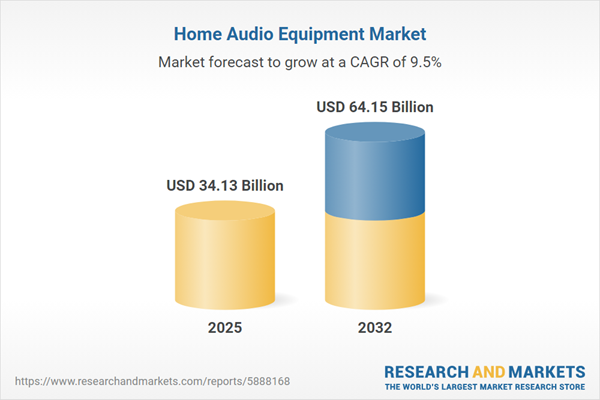Speak directly to the analyst to clarify any post sales queries you may have.
The home audio equipment market is evolving rapidly, shaped by advances in connectivity, changing consumer demands, and integrated digital experiences. Stakeholders should anticipate ongoing transformation as preferences and technologies continue to shift.
Market Snapshot: Home Audio Equipment Market Size and Growth
The home audio equipment market grew from USD 31.12 billion in 2024 to USD 34.13 billion in 2025. It is expected to continue its growth trajectory at a CAGR of 9.46%, reaching USD 64.15 billion by 2032. Demand is being propelled by the proliferation of smart home technologies, immersive sound innovation, and evolving audio content consumption patterns.
Scope & Segmentation of the Home Audio Equipment Market
This comprehensive analysis examines core segments and regions, providing decision-makers with a detailed view of targeted opportunities:
- Product Type: Amplifiers, Receivers, Soundbars (including Dolby Atmos, systems with or without subwoofers, wired and wireless options), Headphones (in-ear, on-ear, over-ear in both wired and wireless variants, including true wireless formats), Speakers (bookshelf active/passive, floorstanding active/passive, outdoor, portable, in-wall/in-ceiling), Subwoofers.
- Distribution Channels: Consumer electronics stores, online retail, hypermarkets and supermarkets, specialty stores.
- End User: Residential consumers, commercial segments such as hospitality and entertainment venues.
- Technology: Wired, wireless configurations, multi-room and smart ecosystem integration.
- Regional Coverage:
- Americas: North America (United States, Canada, Mexico), Latin America (including Brazil, Argentina, Chile, Colombia, Peru).
- Europe, Middle East & Africa: Europe (United Kingdom, Germany, France, Russia, Italy, Spain, Netherlands, Sweden, Poland, Switzerland), Middle East (United Arab Emirates, Saudi Arabia, Qatar, Turkey, Israel), Africa (South Africa, Nigeria, Egypt, Kenya).
- Asia-Pacific: China, India, Japan, Australia, South Korea, Indonesia, Thailand, Malaysia, Singapore, Taiwan.
- Key Companies: Sonos, Bose, Sony, Samsung, LG, Apple, Panasonic, Harman International, Yamaha, Bowers & Wilkins.
Key Takeaways for Senior Decision-Makers
- Consumer adoption is increasingly shaped by advancements in wireless protocols, voice assistant integration, and compatibility across digital content platforms.
- Segment dynamics reveal that product innovation, such as object-based surround and adaptive noise cancellation, is becoming a point of competitive differentiation.
- Premium and entry-level offerings are gaining traction through diverse retail channels, with online direct-to-consumer models facilitating broader global reach.
- Sustainability is becoming critical for brand positioning, as eco-conscious design and responsible sourcing resonate with buyers and set industry benchmarks.
- Collaboration between technology providers and audio specialists is accelerating new feature rollouts, shaping consumer expectations and ecosystem synergies.
- Regionally, developed markets emphasize premium experiences and integration, while emerging regions focus on affordability and mobile-friendly solutions.
Tariff Impact: Strategic Considerations for Cost Structure and Sourcing
Tariff measures affecting home audio equipment imports are prompting manufacturers to reevaluate supplier networks and production locations. Many are diversifying supply chains and expanding domestic sourcing to mitigate risks, preserve margins, and stabilize pricing. Distributors and retailers are also adapting by absorbing partial costs or introducing tiered product lines to sustain demand during periods of pricing volatility. Increased collaboration across the value chain is helping stakeholders manage tariff uncertainty with improved forecasting and contingency planning.
Methodology & Data Sources
The report uses a robust blend of qualitative and quantitative research, featuring executive interviews, product engineer insights, and input from distribution partners. It includes in-depth secondary research—company filings, technical reports, and proprietary databases—to validate market trends and segment performance. Advanced analytics, scenario planning, and peer-reviewed data checks ensure the reliability and accuracy of projected outcomes.
Why This Report Matters
- Enables strategic planning by delivering actionable, segment-level insights across technology, product type, and distribution landscapes.
- Supports risk mitigation amid complex trade environments with detailed analysis of tariff impacts and supply chain adaptability.
- Offers a nuanced assessment of emerging trends in digital content, sustainability, and regional consumer behavior, guiding long-term decision-making.
Conclusion
The home audio equipment market is poised for sustained evolution, creating both challenges and opportunities for industry leaders. With informed strategies and agile operations, companies can capture emerging demand and strengthen market positioning amid changing dynamics.
Additional Product Information:
- Purchase of this report includes 1 year online access with quarterly updates.
- This report can be updated on request. Please contact our Customer Experience team using the Ask a Question widget on our website.
Table of Contents
3. Executive Summary
4. Market Overview
7. Cumulative Impact of Artificial Intelligence 2025
Companies Mentioned
The companies profiled in this Home Audio Equipment market report include:- Sonos, Inc.
- Bose Corporation
- Sony Corporation
- Samsung Electronics Co., Ltd.
- LG Electronics Inc.
- Apple Inc.
- Panasonic Corporation
- Harman International Industries, Incorporated
- Yamaha Corporation
- Bowers & Wilkins Group Ltd
Table Information
| Report Attribute | Details |
|---|---|
| No. of Pages | 191 |
| Published | October 2025 |
| Forecast Period | 2025 - 2032 |
| Estimated Market Value ( USD | $ 34.13 Billion |
| Forecasted Market Value ( USD | $ 64.15 Billion |
| Compound Annual Growth Rate | 9.4% |
| Regions Covered | Global |
| No. of Companies Mentioned | 11 |









